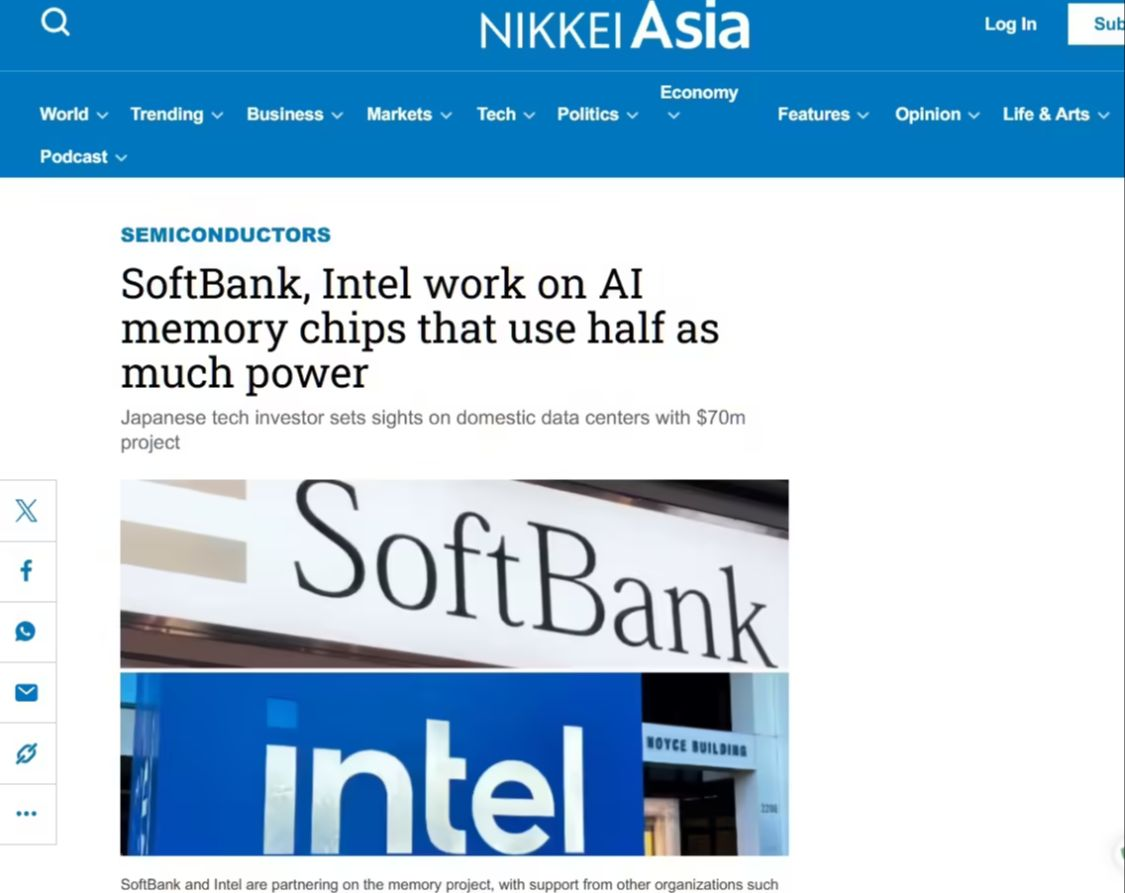SoftBank and Intel Join Forces: Saimemory Develops New AI Memory Chips
In the era of rapid development of artificial intelligence (AI) technology, the demand for computing power is growing explosively, which inevitably puts higher demands on memory chips. High-bandwidth memory (HBM) has become a market focus due to its ability to meet the data throughput requirements of AI processors. However, the high cost, high power consumption, and heat generation resulting from its complex manufacturing process pose significant challenges to further development. Against this backdrop, SoftBank and Intel have joined forces to establish a new company, Saimemory, aiming to reshape the memory chip market with innovative low-power, low-cost stacked DRAM technology.
Background and Objectives of the Collaboration
With the widespread application of AI technology, the performance requirements for memory chips in AI data centers have become increasingly stringent. Traditional HBM, while excelling in data throughput, has gradually revealed its drawbacks of high cost and high power consumption. High power consumption not only significantly increases the operating costs of data centers but also generates a large amount of heat, imposing extremely high requirements on cooling systems and further raising overall costs. Under such circumstances, the market urgently needs a memory chip solution that can meet the data processing demands of AI while effectively reducing power consumption and cost.
SoftBank and Intel have keenly identified this market demand and decided to collaborate to establish a new company named Saimemory, focusing on the development of new AI memory chips. The two parties plan to design a new type of stacked DRAM chip, using a wiring method different from existing HBM, with the expectation of reducing power consumption by about half. According to the plan, the new chip's capacity will be at least doubled compared to traditional DRAM, with power consumption reduced by 40-50% compared to existing HBM, and the cost will be significantly lower than current HBM solutions.
Technical Approach and Collaboration Model
Saimemory's technical approach focuses on optimizing 3D stacked architecture. By vertically stacking multiple DRAM chips and using Intel's Embedded Multi-die Interconnect Bridge (EMIB) technology, the new chip can increase storage capacity while significantly reducing data transfer power consumption. Unlike Samsung, NEO Semiconductor, and other companies that focus on capacity enhancement in 3D DRAM, Saimemory is more focused on solving the power consumption pain points of AI data centers, aligning with the industry trend of green computing.
In terms of technical collaboration, Intel provides its advanced packaging technology, while Japanese academic institutions such as the University of Tokyo contribute memory architecture patents. SoftBank has invested 3 billion yen to become the largest shareholder, with an initial research and development fund of 15 billion yen to be used for prototype design and mass production evaluation before 2027, with plans to achieve commercialization by 2030. Saimemory will focus on chip design and patent management, while the manufacturing process will be outsourced to external foundries.
Differentiated Competition with Other Companies
In the memory chip field, Samsung, NEO Semiconductor, and other companies are also actively developing 3D DRAM technology, but Saimemory has differentiated itself from them. While Samsung, NEO Semiconductor, and others aim for a single-module capacity of 512 GB, focusing mainly on capacity enhancement, Saimemory is more focused on solving the power consumption pain points of AI data centers, aligning with the current industry trend of green computing. In today's AI data centers, where energy consumption and cost are increasingly important, Saimemory's technical approach undoubtedly holds greater market potential.
Market Prospects and Outlook
 The development of the new AI memory chip is expected not only to address the current power consumption and cost issues faced by AI processors but also to lay the foundation for Japan's energy-efficient AI infrastructure. Globally, with the widespread application of AI technology, the demand for high-efficiency, low-power memory will continue to grow. Once Saimemory's chip is successfully commercialized, it is expected to capture a significant market share globally and drive technological changes in the entire memory chip industry.
The development of the new AI memory chip is expected not only to address the current power consumption and cost issues faced by AI processors but also to lay the foundation for Japan's energy-efficient AI infrastructure. Globally, with the widespread application of AI technology, the demand for high-efficiency, low-power memory will continue to grow. Once Saimemory's chip is successfully commercialized, it is expected to capture a significant market share globally and drive technological changes in the entire memory chip industry.
The collaboration between SoftBank and Intel represents another important strategic move by tech giants in the field of AI infrastructure. By integrating both parties' technological and resource advantages, Saimemory is expected to make breakthrough progress in the field of new memory chips. In the future, as the technology continues to mature and the market gradually expands, this new AI memory chip will provide strong support for the efficient operation of AI data centers and contribute to the sustainable development of the global AI industry.
Conevo IC Distributor
Conevo is a leading distributor of high-quality integrated circuits (ICs), specializing in providing reliable and innovative solutions for various electronic applications. Our extensive product portfolio includes a wide range of popular IC models, each designed to meet specific industry needs. Here are some of our hot recommended IC models:
● NCV317LBDR2G: A robust automotive-grade LIN transceiver with high EMI immunity and low power consumption, ideal for automotive electronic systems.
● MCP73831T-2DCI/OT: A versatile single-cell Li-ion battery charger with a wide input voltage range and thermal regulation, suitable for portable electronic devices.
● TLV803SDBZR: A low-power, 3-channel comparator with rail-to-rail input and output, perfect for precision signal processing in compact designs.
Website: www.conevoelec.com
Email: info@conevoelec.com








